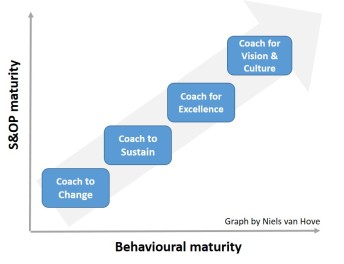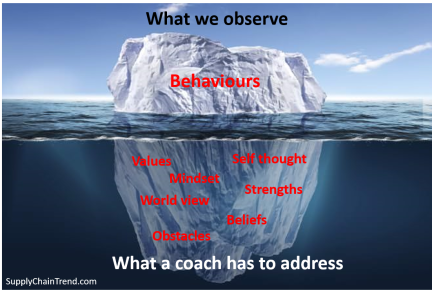The Net Promoter Score (NPS) measures the loyalty that exists between a provider and a consumer. The provider can be a company, employer or any other entity. The provider is the entity that is asking the questions on the NPS survey. The consumer is the customer, employee, or respondent to an NPS survey. (Wikipedia)
Based on a single question, the NPS approach devises the results in to three groups:
- Promoters: likely to exhibit value creating behaviours.
- Detractors: less likely to exhibit value creating behaviours.
- Passives: behaviours falls somewhere in the middle of promotors and detractors.
S&OP can be seen as a provider to a business and its employees. To reach S&OP excellence is a long journey, sometimes estimated at minimal 10 years, and we need leadership and employee engagement and support along the way. It is therefor critical to understand S&OP stakeholder support for value creating behaviours during this journey. As an S&OP expert and a trained and accredited coach, I define four value creating behavioural phases a business has to address during its S&OP journey.
Value creating S&OP coaching phases
Coach to Change: The coaching goal in this phase is to increase acceptance and display of value creating S&OP behaviours like process and meetings disciplines, sharing functional plans, open communication, transparent data usage, public KPI sharing and cross functional cooperation. The coach also can help individuals to reduce behaviours that are obstructive to S&OP and which are often driven by personal styles and security need. Coaching to change will be applied in the early life cycle of S&OP.
Coach to Sustain: To further cement these initial preferred S&OP behaviours and make the newly build S&OP foundation more sustainable, two other core elements of S&OP behaviour need to be developed. We need to coach to sustain and improve Trust and Communication. The coaching goal in this phase is to support a coaching counterpart in improving behaviours that build Trust and open Communication in support of S&OP.
Coach for Excellence: Once a strong foundation of trust and communication is developed and many senior S&OP stakeholders have improved communication and display trust behaviours, the next phase is to coach for excellence. Coaching for excellence requires to go in depth and help individuals develop more effective mindset, self-thoughts and behaviours. The coaching goal in this phase is to build critical mass in personal behavioural excellence in support of S&OP and the wider business
Coach for Vision and Culture: Once a critical mass of leaders and S&OP stakeholders show effective mindset and behaviours, S&OP effectiveness will increase. With increasing process and behavioural effectiveness, the S&OP meetings will become the most important governance structure in the business. The coaching goal in this phase is to help S&OP leaders to use S&OP to proactively influence a more effective and positive company wide culture.
S&OP behavioural maturity and the Net Promotor Score
For every phase as previously described, you need a critical mass of S&OP stakeholders support for value creating behaviours, before you can move to the next phase. In other words, you need promoters. Therefor you would like to know for every phase the NPS. In my holistic S&OP maturity model, I use surveys to measure S&OP engagement to understand what the behavioural support -or lack of it – might be. Reasons for lack of behavioural support are not always easy to detect and often found below the surface, as we can see from below picture.
It is important to understand value creating behaviours for S&OP and the support you have for those behaviours from S&OP stakeholders. With an NPS approach you can get insights in S&OP value creating behavioural support. Based on the four coaching phases I’ve defined, you can ask the following questions to S&OP stakeholders:
Coach to Change: How likely is it that you pro-actively support S&OP change? Or, how likely is it that you support open communication, plan sharing, KPI visibility, etc.
Coach to Sustain: How likely is it that you pro-actively build trust and improve communication between functions?
Coach for Excellence: How likely is it that you will develop and maximize effective personal behaviours?
Coach for Vision and Culture: How likely is it that you will actively display effective behaviours with the intent to influence our culture?
The NPS is a powerful approach, however I will always suggest to ask more than one question to measure S&OP stakeholder engagement during an S&OP journey.
A Net Promoter Score and the future of S&OP
For the last 30 years S&OP has improved business planning, working capital, service levels and integrated decision making. However, S&OP has not yet substantially delivered on its ultimate promise of enterprise wide resource management, rolling forecasting and strategy deployment. This type of S&OP excellence can engage employees with periodic communication updates on business priorities, and budget and strategy status. Furthermore, S&OP leaders who excel at value creating behaviours, can influence company culture for the better by continuously displaying these behaviours in S&OP meetings.
S&OP is often implemented from a Supply Chain perspective and the NPS in the supply chain community will likely be favorable.However, for S&OP to move forward from a supply chain biased business operating model to an operating model that is influencing company culture and deploying strategy, S&OP requires positive cross functional NPS scores along the four behavioural phases as described. Not just from the supply chain and operations function, but also from finance, strategy and people & culture.
So tell me, would you use an S&OP Net Promoter Score?




One thought on “ Why a Net Promoter Score is key to achieve S&OP excellence”